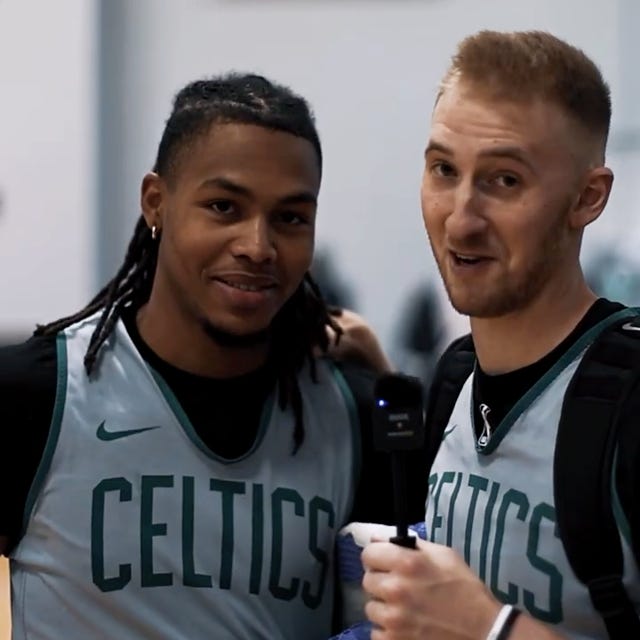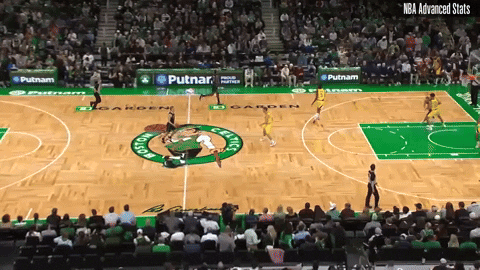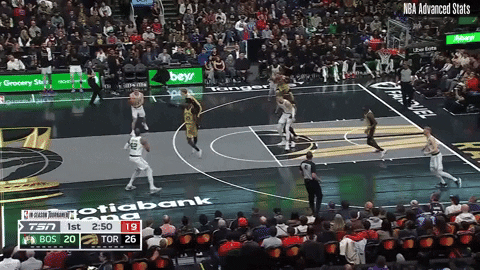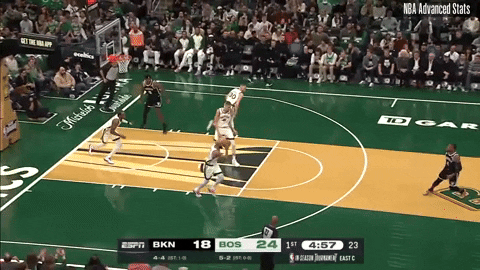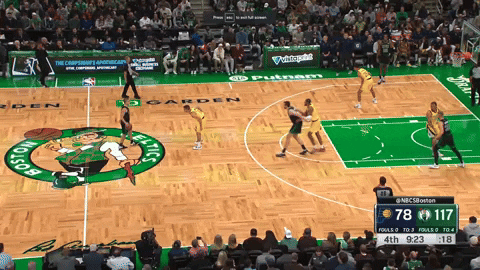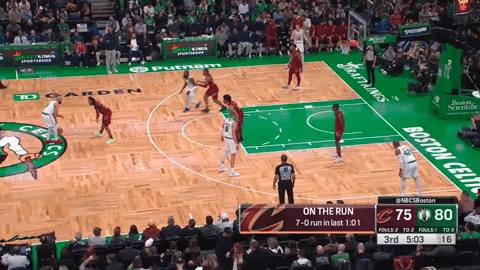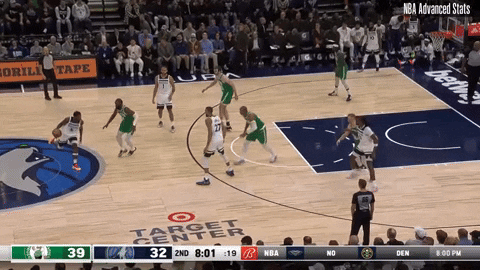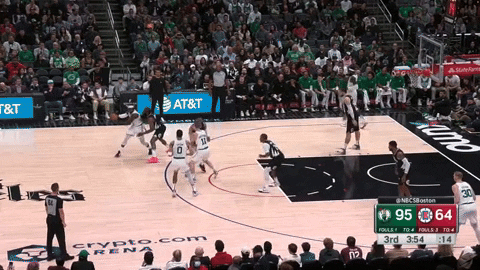The evolution of Sam Hauser
Single-skill players. They have value around the NBA during the regular season. When the playoffs come around, that value quickly diminishes.
You need to have more in your toolbox.
Sam Hauser entered the NBA as a single-skill player. An undrafted sharpshooting forward who excelled during his collegiate days, missing out on a 50/40/90 season by less than 1 percentage point at the line.
During the early days of his tenure with the Celtics, Hauser had one goal: take his shooting ability to another level.
"Overall, I'm just trying to perfect my shooting in different ways, coming off the screens," Hauser told me in 2021, shortly after joining the team. "Maybe taking one dribble and shooting, spot shooting, I think just trying to take my shooting to another level is something I've worked on."
Fast forward to today, and there's no denying Hauser is one of the best movement shooters in the NBA.
He can hit shots coming off flare screens.
He knows how to mirror the ball-handler and relocate into space, giving him high-quality catch-and-shoot opportunities.
He can step into shots when running in transition.
He can operate as the rip screener in stack actions, popping onto the perimeter after creating contact.
And, he can hit perimeter jumpers when curling over screens as part of a larger action – which, in his case, is usually a floppy action.
When Hauser joined the Celtics, this is what we were hoping for – a player who could space the floor, hit his perimeter shots at a high clip, and provide some movement shooting.
We quickly learned he was capable of more, though.
Hauser has emerged as a reliable defender. He can handle defending through contact. He often stays in front of his man. And he contests shots without fouling.
In fact, Hauser has become a reliable 3-and-d player for the Celtics.
“People see a white shooter, I think most people think he can’t play defense,” Mazzulla said after the Celtics beat the Houston Rockets on Jan. 13. “Yeah, I said it. And he’s been able to play defense since I’ve coached him in Summer League (in 2021), and he does a really good job of taking tendencies, does a really good job of understanding who he’s guarding.”
It's funny Mazzulla should mention the 2021 Summer League in this quote, because this is what Hauser told me at the time.
"Overall, with my defense, I think in Summer League I did pretty solid, but now going against NBA All-Stars that are on our team like Jayson and Jaylen, it's really testing me in a good way as well."
Those tests have helped accelerate Hauser's defensive development. He's in his third NBA season and is playing a key role off the bench on arguably the best team in the league. You don't earn those consistent minutes if you're a single-skill weapon. Otherwise, Svi Mykhailiuk would be getting consistent floor time, too.
No, you need to have more to your game. If you want to play on this Celtics team, you've got to be capable of defending at a high level. That means understanding when and how to switch and doing it with purpose. Being able to guard in isolation, be passable when defending in space, and contest every shot like the game is on the line.
Take a look at this possession. Watch how Hauser flies around the court. It starts with a slight dig on the perimeter, forcing the ball-handler to pass the rock. Hauser then contests the initial three-point shot, having enough impact that it clanks off the rim.
The New York Knicks get the rebound. Hauser quickly trails the cutter. As the pass is made to the wing, Hauser is involved again, peeling off to provide ball pressure. He gets beat on the crossover. The Knicks put the ball in rotation. Hauser doesn't give up, though. Instead, he follows the action and rotates to the second side action on the floor, once again contesting a corner three.
That's the type of defense he brings. He plays within the system and tries to impact the game to the best of his ability. Here's another example.
Hauser finds himself being put into the initial pick-and-roll action. The Indiana Pacers get the switch they want and drive middle from the wing. Jrue Holiday rotates over and kills the drive, forcing the Pacers to kick the rock out to the strong side corner. Hauser switches onto the shooter and gets there in time to pressure the shot release, forcing a miss.
He can also play some straight-up man-to-man defense.
Here is Hauser playing some robust post defense on Naz Reid. He drops his center of gravity by lowering his body and pushing his hips into Reid's thighs – look at how Hauser's knees and hips are angled. This allows Hauser to absorb contact without being dislodged.
Yes, Reid backs him down, but he doesn't create space. The play ends in the Minnesota Timberwolves big man taking a tightly contest hook shot, which clanks.
And here he is, holding his own on the perimeter after being switched onto Darius Garland.
Hauser has proven he can defend. He has proven he isn't a liability when switching across positions. And he's proven he isn't a single-skill player at the NBA level. However, this season, he's proving he can do a little more than shoot the three ball on the perimeter, too.
Let me premise this by saying that every high-level shooter needs to have other ways of scoring. If you want to keep the defense honest, you need to prove you can attack close-outs. That means being able to take a couple of dribbles and hit a mid-range shot or drive baseline before kicking it out to a cutter or another stationary shooter. Or finding ways to improve your mid-range game and rim finishing.
Sign up for Celtics Film Room
Like what you've read so far? Want to have it sent to your inbox whenever a new edition is released? Sign up for free! Join the hundreds (I can't wait for this to say thousands) of other subscribers already here and help me scale this newsletter so I can eventually take it to the moon 🚀
No spam. Unsubscribe anytime.
Throughout the first half of this season, Hauser has flashed a couple of different counters to how opposing defenses are looking to pressure him on the perimeter.
He's attacking with drives out of the corner, where he looks to hit whoever is in the weakside dunker or sitting under the rim.
He's rejecting screens and cutting toward the basket, blowing the defense open and creating high-quality looks at the rim.
And he's also learning how to finish through contact at the rim – either with a dunk or with a finesse finish.
I'm not going to sit here, writing this, and pretend Hauser is developing into a multi-level scoring threat. Or that he's suddenly operating like a high-level wing capable of being a secondary or tertiary option on a contending team. That's not his game, and it's not his role.
What he has done, though, is continually improve over his first 2.5 seasons in the league. He recognized he needed to improve defensively if he wanted to become a valuable rotation player who could earn minutes in the playoffs. Then, he began adding additional wrinkles to his skillset so defenses wouldn't bog him down around the perimeter and limit his effectiveness as a shooter.
Hauser has been a success story for the Celtics. They initially signed him to a two-way deal shortly after he went undrafted. They developed him in Maine alongside fellow rotation member Luke Kornet. He got his opportunities with the main NBA team, and he took them with both hands.
Within six months, he signed a contract for the remainder of the season. Then, he signed another contract. Now, he's a top-8 rotation guy on the best team in the NBA, with the best record in the NBA.
The development is happening slowly but steadily. Hauser is now one of the most respected three-point shooters in the league. He's adding to his game. He's proving he's not a target on the defensive end.
On a team full of All-Star-level talent, some of the role players' developments are easily overlooked. There's too much good stuff going on with the team to consistently notice every little detail.
So, I wanted to use today's newsletter to give Hauser his flowers, as the kids would say. He deserves it. He's been fantastic in his role all season. He's showing the value of using the G-League to develop and evaluate talent while also using it as a platform to gain a future contract with the team. We're seeing the same this year with Neemias Queta. Brad Stevens deserves a lot of credit for the success he's having with creating a pipeline in Maine. It's going to pay dividends moving forward.
Sign up for Celtics Film Room
Like what you've read so far? Want to have it sent to your inbox whenever a new edition is released? Sign up for free! Join the hundreds (I can't wait for this to say thousands) of other subscribers already here and help me scale this newsletter so I can eventually take it to the moon 🚀
No spam. Unsubscribe anytime.


